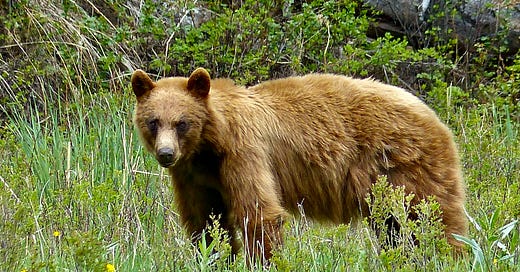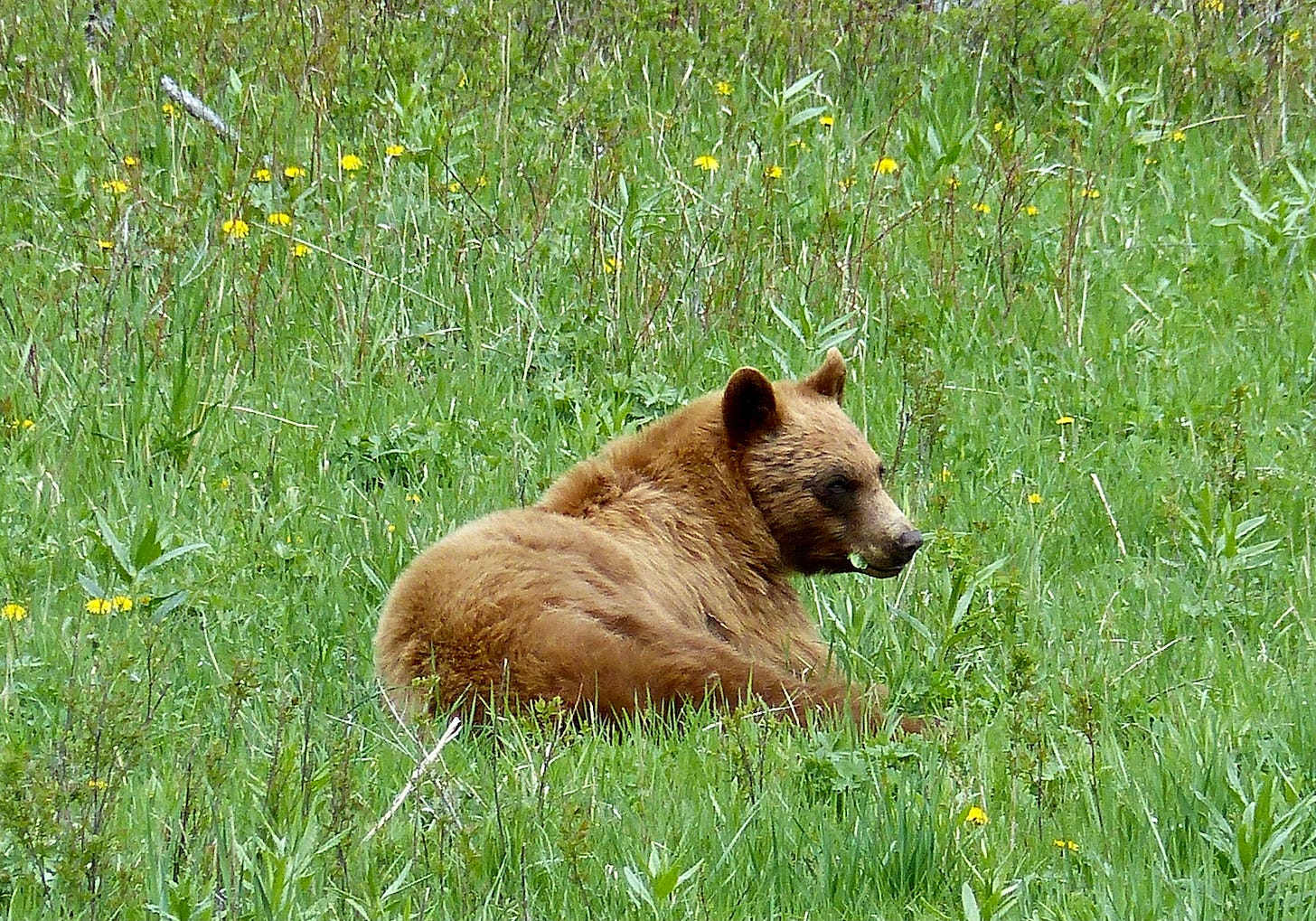While hiking in Yellowstone’s backcountry, Mary and I and a few friends were lucky to spend time watching this cinnamon-colored black bear. We stayed far away and I took this image with a telephoto lens. While this bear knew (as the photo shows) that we were present, we were glad to see that our presence didn’t change its behavior. The bear continued to eat, sit, and lay in this meadow surrounded by conifers. As we enjoyed this moment, I realized that I knew little about black bears. I decided to fix that once I returned to the office. What I found increased my appreciation of these animals.
I was surprised to learn from the National Park Service that only about half the black bears in Yellowstone are black. Other colors include cinnamon, blond, or brown, and a bear so colored might be mistaken for a grizzly. But grizzlies are larger and have a shoulder hump, smaller ears, and a concave facial profile.
I’ve noticed how black bears sometimes do not generate as much excitement as grizzlies. I’ve heard some Yellowstone visitors lament, “Oh, that’s just a black bear.” But black bears should be respected as true survivors; they’ve lived in North America longer than grizzlies. About 1.5 million years ago ancestors of the black bear began roaming Eurasia. They eventually crossed the Bering Land Bridge into North America and over the eons evolved into the American black bear. Grizzlies followed later, joining the black bear and a giant short-faced bear in the Yellowstone area.
That giant short-faced bear would have been something to see, although I wouldn’t want to spook one while hiking in the backcountry. Giant short-faced bears weighed as much as 2,000 pounds (a large black bear weighs less than three hundred) and stood six feet tall at the shoulder when on all fours (a black bear stands three feet tall at the shoulder). The short-faced bear was perhaps the largest and fastest carnivore to roam North America, bringing down bison, horses, and even mammoths. But bigger isn’t always better. By the end of the last Ice Age, the giant short-faced bear was extinct, perhaps out competed by grizzlies or victimized by climate and habitat change.
With the short-faced bear gone, the black bear still had to coexist with the grizzly. One secret to their success is that black bears took to wandering woodlands and left the open landscape to grizzlies. By doing so they avoided contact, competition, and conflict. Yellowstone, by the way, is one of the few areas south of Canada where black bears and grizzlies both live today.
Visitors have watched Yellowstone’s black bears since the park’s early days. By the late 1880s black bears fed in open-pit garbage dumps near park hotels. Nightly viewing of hungry bears became a must-see for wildlife-starved tourists. Until 1960, visitors could even feed black bears along the roadside, as many iconic photographs show. But by 1970, Yellowstone administrators closed the garbage dumps and forced black bears away from visitors and back to their natural diet.
And what a diet it is. While we watched this bear dine on spring’s lush new grasses, black bears are omnivorous; they will eat almost anything: grass, fruit, insects, eggs, fish, elk calves, carrion, and even the living tissue just beneath a tree’s bark. Such a varied diet, scientists speculate, could have helped black bears outlast that giant short-faced bear which may have fed primarily on meat.
Black bears are well equipped physically for survival. They are top-notch climbers, fast runners, and powerful swimmers. Their eyesight and sense of hearing are better than ours. But their strongest sense is that of smell, which is about seven times greater than a dog’s.
Perhaps the biggest survival accomplishment of black bears is their amazing ability to handle the onslaught of yet another species: Homo sapiens, with our never-ending population increase and steady encroachment into bear territory. While grizzlies survive in only five states, black bears somehow manage to share territory with us in at least forty states.
When we finally moved on, the bear was resting, well fed and warmed by the sun. I’m happy I had the chance to spend a moment with this bear and learned how black bears have survived the test of time, life with larger competitors, and the encroachment of humans.
Thanks for joining me in this Love the Wild.
If you enjoyed this Love the Wild, please spread the joy and share it with others.
You’ll receive a Love the Wild in your inbox each week. In addition to stories such as this one, you’ll enjoy a variety of podcasts, slideshows, photo essays, commentaries, excerpts from my books and more. With each, I hope to warm your heart and excite your mind as we share moments with wildlife and in wild lands.
Please log in to comment. I love reading and replying to your comments.
I write and photograph to protect wildlife and preserve wild lands.
My bestselling In the Temple of Wolves; its sequel, Deep into Yellowstone; and its prequel, The Wilds of Aging are available signed. My books are also available on Amazon unsigned or as eBook or audiobook.
Image Credits: Photos by Rick Lamplugh







We were able to photograph and enjoy two different black bear mamas with coy last October. One was near the Blacktail Plateau Drive, don’t remember the other. They grazed on hillsides and were fun to watch, especially the cubs. I enjoy learning from you, especially about the short faced bear! We spent a few days on Lake Superior in the Michigan UP recently. There had recently been black bear sightings but we didn’t spot any. Always a thrill to think maybe… long live the bear!
Thanks for another informative post, Rick! The Coast Range is crawling with black bears, and yet I rarely see them. I suspect they are wilier than we suspect, and this also aids in their remarkable ability to coexist with humans.